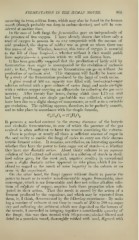Page 795 - My FlipBook
P. 795
FERMENTATION IN THE HUMAN MOUTH. — 805
occurring in twos, seldom fours, which may also be found in the human
mouth (though probably not deep in carious dentine), and will be con-
sidered at another time.
In the case of both fungi the fermentation goes on independently of
the presence of free oxygen. I have already shown that where only a
trace of oxygen is present in no way comparable with the amount of
acid produced, the degree of acidity was as great as where there was
free access, of air. Whether, however, this trace of oxygen is essential
to the life of these fungi— /. e. whether without it they would perish
from asphyxia—is a question which we will not discuss here.
It has been generjjlly supposed that the production of lactic acid by
fermentation from sugar is accompanied by the evolution of carbonic
acid ; in fact, Fluegge says that no fermentation can go on without the
production of carbonic acid. This statement will hardly be borne out
by a study of the fermentation produced by the fungi of tooth caries.
A glass vessel of 500 c.c. capacity was tilled witli becf-extract-sugar
solution infected with a pure culture of caries fungi and made air-tight
with a rubber stopper carrying an efflux-tube for collecting the gas over
mercury. After twenty-four hours, during which time 1.75 c.c. acid
had been produced, one single gas-bubble was collected, which may
have been due to a slight change of temperature, as well as to a veritable
gas-evolution. The splitting appears, therefore, to be perfectly smooth,
and to take place in accordance with the simple formula,
CsHiaOg = 2C3lIg03.
It presents a marked contrast to the stormy character of the butyric
and alcoholic fermentations, in case of which the pressure of the gas
evolved is often sufficient to burst the vessels containing the cultures.
There is perhaps at nearly all times a sufficient amount of sugar in
the oral cavity to enable the fungi of caries to carry out their charac-
teristic ferment action. It remains, nevertheless, an interesting question
whether they have the power to form sugar out of starch i. e. whether
they have any diastatic action. About thirty cultures in an aqueous
solution of beef-extract and starch and in a solution of starch in steril-
in exceptional
ized saliva gave, for the most part, negative results ;
cases a slight diastatic action appeared to take place, which I am in-
clined to regard as the result of some impurity in the culture or an
error in the experiment.
On the other hand, the fungi appear without doubt to possess the
power to invert or to render non-fcrmcntable sugars fermentable, since
cane-sugar, which is not fermentable and does not reduce alkaline solu-
tions of sulphate of copper, acquires both these properties when sub-
jected to their action. That this result is caused by the action of a
ferment produced by the organisms, and which may be separated from
them, is, I think, demonstrated by the following experiment : By mak-
ing a number of cultures at one time in vessels of 200 to 500 c.c. capa-
city and collecting the sediment which was deposited on the bottom of
the vessels, I succeeded in bringing together a considerable quantity of
the fungi; this was then treated with 90-per-cent. alcohol filtered and
dried in a porcelain vessel, thoroughly rubbed with sand, digested with


